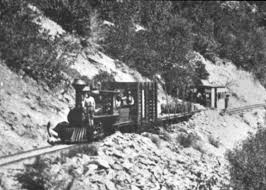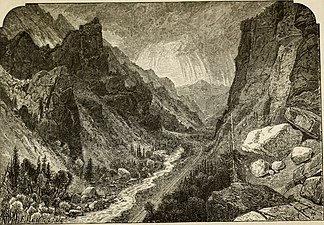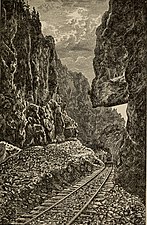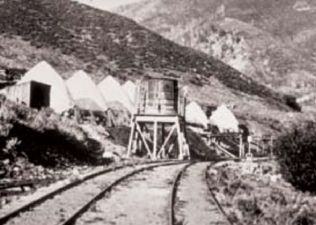American Fork Railroad
| American Fork Railroad | |||||||||||||||||
|---|---|---|---|---|---|---|---|---|---|---|---|---|---|---|---|---|---|
|
American Fork Canyon , 1876: 1. Mt. Aspinwall or Lone
Mountain. 2. Mountain peaks. 3. Picnic Grove, Deer Creek. | |||||||||||||||||
| Route length: | 26 km | ||||||||||||||||
| Gauge : | 914 mm ( English 3-foot track ) | ||||||||||||||||
| Maximum slope : | 56 ‰ | ||||||||||||||||
|
|||||||||||||||||
The American Fork Railroad was a 16 mile long narrow gauge railway with a gauge of 3 feet (914 mm) from American Fork to Forest City , Utah , which operated from 1872-1878.
founding
The American Fork Railroad was founded by New York businessmen on April 3, 1872 as a subsidiary of the Miller Mining and Smelting Company, and the founding papers were filed with the Auditor of Public Accounts on April 16, 1872. It was directed by Major Edmund Wilkes of Salt Lake City, who also ran the mining company.
The line was surveyed from April 30, 1872, and the routing began on June 3, 1872. On July 14, 1872 enough rails for about 11 kilometers of track and 10 flat cars had arrived, but track laying did not begin until June 22 1872.
Track construction
Originally it was planned that a 32 km long route from a train station on the still-to-be-built Utah Southern, near American Fork City, should lead to the Sultana Smelter, which lay above the Fork Canyon. The route of the railroad was to follow the American Fork River north and later northeast , from a transfer station in American Fork on Utah Southern , and then through the American Fork Canyon . At the point where the canyon forks to the northeast and southeast, the railroad followed the northeast branch up and was supposed to run as far as Sultana Smelter to the point in Forest City now called Dutchman Flat. The route overcame an altitude difference of 580 m (1900 feet) and was unusually steep in places: On the steep stretches , as an adhesion railway with 56 ‰ , it overcame an altitude difference of 56 meters per kilometer (296 feet per mile).
The route was completed as far as Forest City, but the tracks were only laid as far as Deer Creek by September 29, 1872, which is about 6.5 kilometers below the gold and silver smelter , which is now a small reservoir. A few days earlier, the Utah Southern rail line to Lehi had been completed, about three miles northwest of American Fork. The Utah Southern decided not to extend it any further for the time being. Thereupon the Utah Southern and the American Fork Railroad agreed that the American Fork Railroad could lay their narrow-gauge tracks on the route of the Utah Southern. This lasted until September 1873, but shortly afterwards the route was re- gauged when Utah Southern was extended further south to American Fork.
business
The operation of the railroad achieved no economic success. The Mason steam locomotive originally used on a trial basis, which weighed only 14 or 15 tons, was unsuitable for the task. Therefore horses and mules were used to pull the empty wagons up the mountain. Downhill they drove properly braked only driven by gravity.
In the summer season of 1875 the line was only operated on Mondays, Wednesdays and Fridays and not at all in winter. Since the traffic volume of the mining companies was lower than forecast, excursions were offered to tourists. Nevertheless, the operation was uneconomical, so that the operation was stopped and the tracks were torn down in the late spring and early summer of 1878. The Deseret Evening News commented on the dismantling of the route by mistakenly forecasting on June 5, 1878 that the canyon would hardly be visited by tourists in the future (the canyon “... is not likely to be visited in future, to any extent, by tourists ”), But this has not been the case due to increasing car tourism. The rails and cars were probably sold to Charles W. Scofield , the owner of the Bingham Canyon Railroad of the Camp Floyd Railroad and the Wasatch & Jordan Valley Railroad , who used them in August 1878 for the construction of the Utah & Pleasant Valley Railroad .
Locomotives
| No. | Manufacturer | Wheel alignment | Factory no. | Construction year | cylinder | bikes | Weight | Remarks |
|---|---|---|---|---|---|---|---|---|
| First AFRR No. 1 | mason | 0-4-4T | 461 | July 1, 1872 | 10x15 " | 33 " | 13.5 t | Sold to Eureka & Palisade Railroad circa December 1873 . Sold to Nevada Central Railroad Oct. 1879 . Sold to Utah & Northern Railroad in December 1882 . Scrapped in 1886. |
| Second AFRR No. 2 | porter | 0-6-0 | 151 | April 30, 1874 | 12x16 " | 33 " | 20 t | Sold with wagons and rails to Utah & Pleasant Valley Railroad in late 1878 . |
Hut at Tibble Fork
Individual evidence
- ↑ a b c d e f Don Strack: American Fork Railroad (1872−1878). June 7, 2013. Accessed September 21, 2018.
- ^ The American Fork Canon. In: The Pacific tourist: Williams' illustrated trans-continental guide of travel, from the Atlantic to the Pacific Ocean. 1876. pp. 143-148.
Web links
Coordinates: 40 ° 31 ′ 40 ″ N , 111 ° 36 ′ 10 ″ W.







